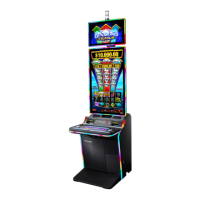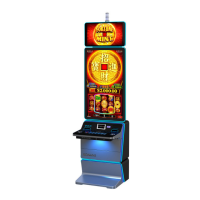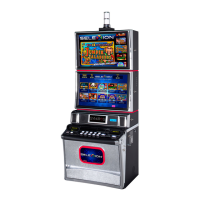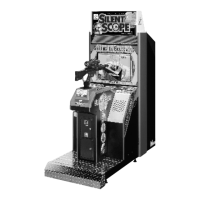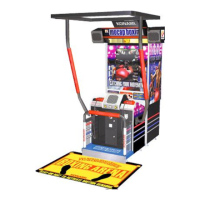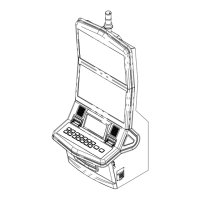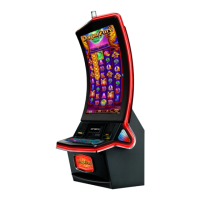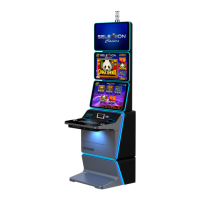
Do you have a question about the Konami KXP and is the answer not in the manual?
| Brand | Konami |
|---|---|
| Model | KXP |
| Category | Arcade Game Machines |
| Language | English |
Steps to start the KXP system in normal mode, including door operation and power.
Steps to enter KMS Mode via reset key and return to Game Mode.
Explains how to use the touchscreen and button panel for menu navigation.
Clears game data, audits, logs, and allows option setting. Required for first start.
Detailed steps to perform the RAM Clear, including machine power and MPU board handling.
Details the different areas of the game screen (Credit, Bet, Win, Game, Help/Denom buttons).
Instructions on how to access the main AUDIT menu from the KMS screen.
Describes the available tabs for viewing audit data.
Explains the function of each item listed in the GENERAL METERS 1 audit screen.
Explains the function of each item listed in the GENERAL METERS 2 audit screen.
Explains the function of each item listed in the SINGAPORE METERS audit screen.
Explains the function of each item listed in the BILL/TICKETS audit screen.
Explains the function of each item listed in the CASHLESS/BONUSING 1 audit screen.
Explains the function of each item listed in the CASHLESS/BONUSING 2 audit screen.
Explains the function of each item listed in the GAME PLAY audit screen.
Explains the function of each item listed in the PROGRESSIVE JACKPOTS audit screen.
Explains the function of each item listed in the PAR GAME audit screen.
Explains the function of each item listed in the PAR DENOMINATION audit screen.
Explains the function of each item listed in the DOUBLE FEATURE audit screen.
Explains the information captured for each log entry type.
Details the information displayed for ticket ins, including number, date, time, and amount.
Details the information displayed for jackpot hits, including number, date, time, and amount.
Details the information displayed for progressive payouts, including number, date, time, and level.
Details the information displayed for cancelled credit handpays, including number, date, time, and amount.
Details AFT transaction information, including type, cashable, and promotional credits.
Details cashout information, including player credits and total cashout.
Shows the status of game events, often related to meters or occurrences.
Details the types of meters available, including Coin In, Coin Out, and Actual Percent.
Details how to navigate between summary, detail pages, and individual game records.
Instructions on how to access the main SETUP menu from the KMS screen.
Describes functions for Machine Number, Locale, Credit, Cash Device, Security, Communications, Sound, Game Common, Paytable, and Denomination setups.
Explains how to set the machine serial number and asset number.
Details setting the Model field using a digital keyboard, specific to International versions.
Details entering the asset number using a numeric keyboard.
Instructions for changing the machine's internal clock and date settings.
Details settings for credit limit, hopper, jackpot reset, machine cashout, and jackpot limits.
Provides detailed descriptions for each item in the CREDIT SETUP screen.
Details configuration options for Bill Validators and Printers.
Details how to select the type of printer to be used.
Details setting custom titles for non-cashable, debit, and demo print tickets.
Explains how to enable/disable meters for coin in, coin out, total drop, jackpot attendant pay, and total bills.
Sets currency type, autoplay, and KMS cash/credit display.
Sets the absolute credit limit using a numeric keyboard.
Sets the minimum duration for a game session.
Describes importing XML license files via USB.
Explains features designed to prevent unauthorized license tampering.
Sets address and protocol for three communication connections.
Sets the address and protocol for communication channels CH1, CH2, and CH3.
Sets the communication channel for machine control commands.
Enables/disables remote handpay reset, handpay queue, and handpay reporting.
Manages OCSP settings, certificate authorities, responders, store, and diagnostics.
Configures validation mode (standard, secure, system) and ticket out behavior.
Sets voucher/coupon expiration, UTC offset, and machine location details.
Allows EFT and AFT cashless transfers, including In-House, Debit, and Bonus options.
Selects the progressive controller (None, Mikohn, SAS) and jackpot award type.
Selects between DHCP and Manual network setup types.
Sets master volume, error volume, and speaker configuration.
Instructions for accessing the Game Common Setup menu.
Configures credit intervention, attract mode, and attract interval.
Sets color and brightness for idle and game play illumination LEDs.
Configures standard or alternating e-art display, and time for art screens.
Sets the default language for the system.
Sets the time limit for making selections during bonus rounds.
Selects art to be displayed in the topper, such as Konami logo or game art.
Sets payout percentages for each denomination of a selected game.
Selects the number of play lines for domestic versions of the game.
Sets the default game denomination when Attract mode starts.
Sets progressive hit frequency, denomination category, multiplier, and time limit.
Sets the trigger multiplier and time limit for bonus rounds.
Sets progressive level options to Link, Standalone, or None.
Allows setup of applicable games, including paylines, cost, bets, and TRTP.
Displays informational summary data for each game, not configurable.
Displays informational summary data for the machine, not configurable.
Checks operation of Touch Panel, Buttons, Door, Out Port, Coin Acceptor, Coin Hopper, Hardware Monitor, LEDs.
Instructions for performing the touch test by drawing on the screen.
Details the steps for calibrating the touch panel by touching targets.
Instructions for calibrating bottom touch screens on Stepper models.
Displays the status of the button panel buttons.
Checks the status of door switches and sensors, toggling ON/OFF when opened.
Enables/disables Tower Lamp and Bill Lamp settings for testing.
Enables or disables acceptance or diverter options.
Changes the value of COIN PAY from 1 to 2.
Sets the temperature thresholds for alerts.
Adjusts values for pattern data and group name.
Checks the operations of the seven segment display.
Describes the functions available in the REEL diagnostic screen.
Displays inner reel status and error description.
Checks various reel movements like regular, nudge, rumble, wave, skill stop, speed, step, and short spins.
Sets stop position, speed, direction, and acceleration for reel movements.
Adjusts reel values and sets illumination patterns, color, and speed.
Checks the LED status of outer reels and reel back lamps.
Displays i-socket and FPGA versions of the reel control board.
Displays information about the monitor, such as manufacturer and size.
Sets LED patterns for game name and pattern data.
Notes that this test only works with specific cabinet styles (Monument or Standard).
Enables acceptance mode and resets current errors.
Prints a void ticket for testing the printer.
Changes values for game name, sequence data, master volume, and speaker config.
Displays a test pattern for checking screen operations.
Shows the conditions for communication channels CH1 to CH3.
Describes how to test game combinations by pressing reels and using option buttons.
Shows license status (Activated, Deactivated, Expired) for international versions.
Changes credit meter, bet meter, win meter, and prog levels.
Checks and displays current credit meter levels.
Instructions to place the machine in OUT OF SERVICE mode.
Explains LP21's role in software verification using CRC 16 and seeds.
Explains how the LP21 FAST CRC feature reduces response time.
Explains how to enable/disable LP21 Fast CRC and its effect on diagnostics.
Allows operators to view the LP21 response file in diagnostic mode.
Outlines functions for generating files, arranging modules, running CRC, and running old LP21.
Explains the Key-On Credit feature for attendants and its availability.
Details entering the credit value and employee ID for the transaction.
Explains validation of new values and calculation of credit meter sums.
Explains the RAM Clear option to enable/disable Key-On Credits functionality.
Explains how the Key-On Credits setting is enabled/disabled via a checkbox in Cash Device Setup.
Explains the configurable default value for Key-On Credits.
Details entering and validating transaction values and employee IDs.
Explains that Key-On Credits In data is displayed and its units.
Details the information shown for each transaction record in the log.
Explains how Game Recall shows accumulated Key-On Credit values for completed transactions.
